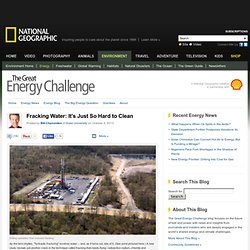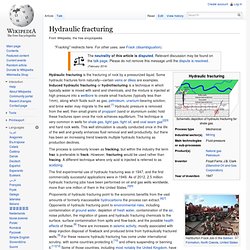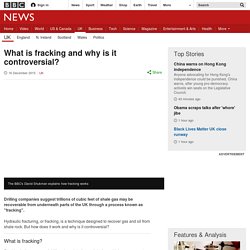

Fracking Water: It’s Just So Hard to Clean. Another crack in the “fracking is safe” story for the industry to address.

You know that fracking thing? For the uninitiated, hydraulic fracturing (a.k.a. fracking) is the technique of injecting water, sand and chemicals at high pressures into shale and other tight rock formations to release the fuel trapped inside. Combined with horizontal drilling, fracking has allowed us to access huge amounts of heretofore unrecoverable natural gas. What a bonanza: a new and sizable source of natural gas. And, at first blush, a fuel that’s good for the environment: natural gas is the cleanest of the fossil fuels and has already begun displacing coal, the dirtiest fossil fuel, in U.S. power plants.
Complications With Fracking But alas, as with most too-good-to-be-true things, fracking’s got some downsides. Wastewater Complication Ideally, the water would be reused or recycled, eliminating the need for immediate disposal. Left: contaminated water in. So how well do these facilities really do? End Note. FracFocus Chemical Disclosure Registry. Secrets of fracking fluids pave way for cleaner recipe. David Zalubowski/AP/PRESS ASSOCIATION IMAGES The chemicals used in hydraulic fracturing to extract oil and gas are being disclosed to online registries.

The myriad liquid concoctions used in hydraulic fracturing make for quite a recipe book. Since January 2011, FracFocus, an online chemical-disclosure registry, has assembled a list of the mixtures used at more than 52,000 oil and gas wells across the United States. In these data, geochemist Brian Ellis sees opportunity. He plans to mix different chemicals into oil- and gas-rich shale rock inside a pair of high-pressure chambers that he is building. The fluids, which are mixed with sand, are predominantly water, laced with 1% ‘special sauce’. Cuadrilla Resources. All water on site is stored in steel tanks – never open pits/ponds – and is tested by the EA on a regular basis.

Once water is ready for disposal, an EA-approved water disposal company removes all waste water for testing and treatment at a licensed wastewater plant. Click the above image to enlarge. Returned waters. The New Oil Landscape - Video: What is Fracking? Shalebubble. In this landmark report, J.

David Hughes from Post Carbon Institute takes a far-ranging and painstakingly researched look at the prospects for various unconventional fuels to provide energy abundance for the United States in the 21st Century. While the report examines a range of energy sources, the centerpiece of “Drill, Baby, Drill” is a critical analysis of shale gas and shale oil (tight oil) and the potential of a shale “revolution.” A print version of the report can be purchased here. Abstract It’s now assumed that recent advances in fossil fuel production – particularly for shale gas and shale oil – herald a new age of energy abundance, even “energy independence,” for the United States. What is shale gas and fracking? - Publications. Wellbore construction. Wellbore construction is critical to protecting groundwater.

We take great care to design and install effective well casing systems. Proper wellbore construction is critical to protecting groundwater. We take great care to ensure the integrity of the wellbore and eliminate any pathway from the contents of the wellbore to drinking water aquifers. During drilling, completions and production operations, all groundwater-bearing rock formations are protected from the contents of the well by layers of steel pipe (casing) and cement sheaths. The process of wellbore construction is highly regulated, including the depth to which casing must be set and the quality of cement used. Conductor casing is typically the first (and largest diameter) pipe installed during construction and usually extends between 25 and 45 metres (approximately 80 to 150 feet) below surface. Cuadrilla Resources. In order to recover the natural gas trapped deep below the surface in rock formations, Cuadrilla’s wells reach depths of over 10,000 feet.

Throughout Cuadrilla’s operations, robust safety measures are in place to protect the environment. BBC Horizon - Fracking: The New Energy Rush. Cuadrilla Resources. Surface Story. Animation of Hydraulic Fracturing (fracking) Schematic Geology of Natural Gas Resources. How Natural Gas Works. Fracking Resource Guide. This website is a crash course in fracking.

At the top and bottom of these pages are links to annotated information about fracking by subject, with each page listing sorted alphabetically. Fracking (fracing, hydraulic fracturing), or hydrofracking, is a method of mining for natural gas which greatly increases the efficiency of extracting shale gas from the ground. Geological experts claim that shale beds in New York, particularly the Marcellus Shale, contain more natural gas than previously estimated. Can we benefit by this new source of natural gas without it affecting our water and lifestyle? The diagram below, provided by Energy in Depth, an Oil and Gas Industry website, portrays a clean, quiet, well site. Hydraulic fracturing uses millions of gallons of water, chemicals and lubricants.
The U.S. Acts of Congress are often designated as public laws when they are intended to protect all members of society in areas of interaction not limited to contract and tort laws. Fracking with propane gel. New-Waterless-Fracking-Method-Avoids-Pollution-Problems-But-Drillers-Slow-to-Embrace-It. World%20Oil%20Article. Hydraulic fracturing. The first experimental use of hydraulic fracturing was in 1947, and the first commercially successful applications were in 1949.

As of 2012, 2.5 million hydraulic fracturing jobs have been performed on oil and gas wells worldwide, more than one million of them in the United States.[4][5] Frac job in progress Geology[edit] Mechanics[edit] Fracturing in rocks at depth tends to be suppressed by the confining pressure, due to the immense load caused by the overlying rock strata and the cementation of the formation.
Veins[edit] Dikes[edit] What is fracking and why is it controversial? Drilling companies suggest trillions of cubic feet of shale gas may be recoverable from underneath parts of the UK through a process known as "fracking".

Hydraulic fracturing, or fracking, is a technique designed to recover gas and oil from shale rock. Cuadrilla Resources. In September 2011, Cuadrilla announced it had discovered 200 trillion cubic feet (tcf) of Gas in Place within the Bowland shale in Lancashire.

If even a fraction of this could be extracted at a commercial rate then this could have a positive effect on the UK’s energy mix. » You’ve Got Shale: The “Where” and “What” of Shale Gas Formations NaturalGas.org. Geologically, gas shales are fine grained, organic-rich, sedimentary rock formations that trap natural gas. Gas shale rock has characteristically small pores that are relatively impermeable to natural gas flow unless they are naturally or artificially fractured to create channels connecting the pores. Shale rock is considered so impermeable that geologists sometimes say it makes marble feel “spongy” in comparison. Shale gas is present across much of North America in basins of both extreme and moderate size. As of 2010, there are at least 22 major shale plays in the U.S., spread diversely over more than 20 states.
Fracking fuels energy debate. This site has been drilled and fractured and is now producing gas. A natural gas drilling site typically covers 6 square acres of land. Drilling down to the gas-rich shale generally takes a couple of weeks, hydraulic fracturing itself about two to three days per well. What recently made fracking, an old technology, all new again was the addition of horizontal drilling.
As shown here, natural gas companies drill down to a certain depth, then essentially start drilling sideways, deep underground. Hydraulic Fracturing water shed council. After a well is fracked, 25-75% of the fluid is returned to the surface along with the oil or gas. The rest of the fluids remain underground. Used fracturing fluids that return to the surface are referred to as flowback. Energy From Shale. Europe Unconventional Gas.